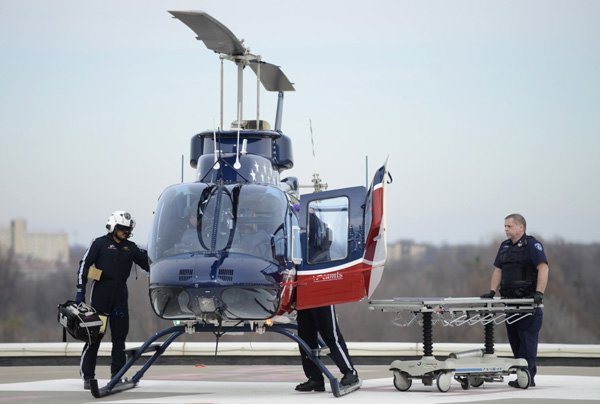Mercy Hospital Springfield, with one of Missouri’s busiest Level I trauma and burn centers, is expected to receive and treat upward of 2,700 critically injured patients by the end of 2012. Some 400 of those will have come from Arkansas, hospital officials said.
They come by ambulance and by Mercy Life Line helicopters waiting in three strategic locations across southern Missouri: Saint Robert, Boliver and Branson West. All together, the ground and flight crews routinely cover a 6,800-square-mile area that encompasses parts of Arkansas, including Benton and Washington counties to the southwest, Sharp County to the east, and White and Woodruff counties to thesouth, said Velvet Reed-Shoults, director of trauma services at Mercy Hospital Springfield.
Arkansas’ only Level I trauma centers are ArkansasChildren’s Hospital and the University of Arkansas for Medical Sciences, both in Little Rock.
“We are closer to those areas than Little Rock,” Reed-Shoults said of the area that Life Line helicopters cover in northern Arkansas. “ However, the rule is the patient goes to the closest appropriate facility that is able to take them. So if Little Rock was full and was diverting patients, then we could fly farther south to pick up someone.”
The Arkansas Trauma Communications Center generally makes the call on where a patient is taken, because the center is constantly updated on which hospital has what capabilities and space at any given time, she said.
“For us, we’ve been doing it a long time, even before Ar-kansas put together a trauma program,” said Reed-Shoults.
Arkansas’ fledgling trauma system, established in 2009, includes other states’ hospitals under the same classification system used for Arkansas hospitals.
Earlier this month, Mercy Springfield Communities, of which Mercy Hospital Springfield is a member, announced the purchase of three new helicopters with upgraded technology for flying where there’s reduced visibility and low clouds. The new helicopters have the capability to operate under the Federal Aviation Administration’s Instrument Flight Rules, just like commercial airlines do.
LEVEL I CARE
Springfield’s Level I trauma hospital has been taking Arkansas’ most severe medical cases longer than most people realize.
“Even before we were a Level I for Arkansas, we provided care to the patients in Northwest Arkansas,” said Dr. Robert C. Johnson Jr., medical director for the trauma unit at Mercy Hospital Springfield.
The types of injuries suffered by patients in Arkansas aren’t different from those suffered by patients fromsouthwest Missouri.
“Unfortunately, we see a lot of people who are involved in motor-vehicle accidents,” Johnson said. “There are a lot of recreational injuries, people who are out hiking that will fall, [all-terrain vehicle] accidents. We occasionally will see a hunting accident. But they’re pretty similar populations.”
As a Level I trauma center, Mercy Hospital Springfield has a trauma surgeon on duty24 hours a day, seven days a week.
“We have the ability when the patient arrives, to be waiting at the bedside for them,” Johnson said. At Level II and III trauma centers, surgeons have to be called in. Level IV centers stabilize severely injured patients and transport them elsewhere for treatment.
In addition to the handson work of saving lives, Level I trauma centers are community resources with trauma education, research and outreach services. Mercy Hospital Springfield’s Injury Prevention Center reaches more than 80,000 people each year through educational programs like car seat, bicycleand all-terrain-vehicle safety, and teen driving.
MORTALITY RATE
The Springfield hospital’s overall mortality rate is 8.1 percent, compared with the national average of 8.8 percent, according to figures compiled by the National Trauma and Data Bank.
“This includes the most severely injured, including the ones we terminate life support per family request and our nonsurvivable injuries placed on comfort care by family,” said Reed-Shoults.
Johnson is complimentary of Arkansas’ progress toward better trauma care.
In 2009, the Arkansas Department of Health said death by injury was the No. 1 killer of Arkansans ages 1-44, and the state’s injury fatality rate was 30 percent higher than the national average. That figure provided part of the impetus for creating the trauma system.
Before Act 393 of 2009, which established the system, Arkansas was one of just three states without a trauma system and the only state in the country without a designated trauma center.
Over the past two years, 75 hospitals in Arkansas have applied to become trauma centers, providing varying levels of care. Children’s Hospital and UAMS became Level I trauma centers in the fall of 2010.
Mercy Springfield Communities includes hospitals in Berryville; Aurora, Mo.; Cassville, Mo.; Lebanon, Mo.; and Mountain View, Mo.
Northwest Arkansas, Pages 11 on 12/30/2012

